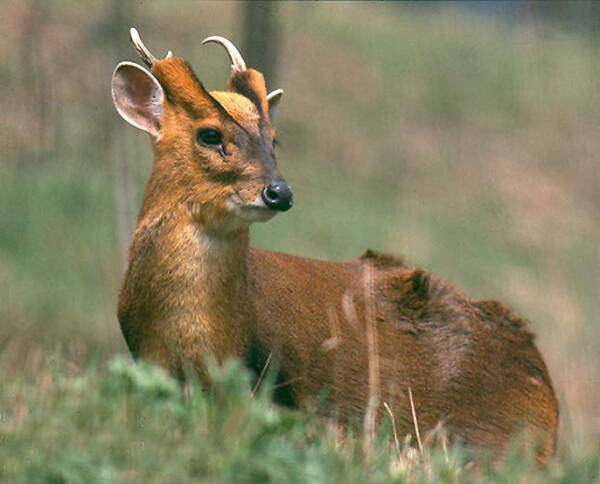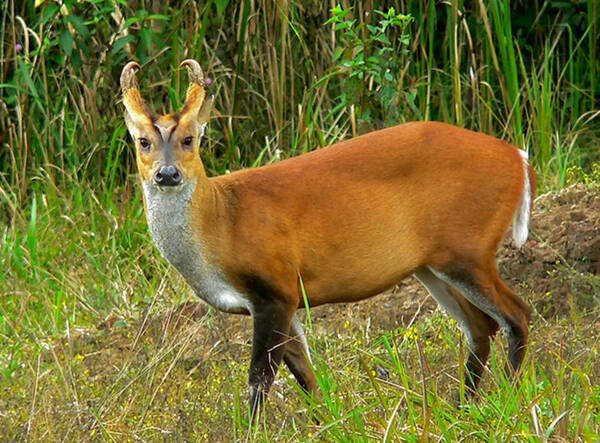Muntiacus muntjak
IUCN
LCBasic Information
Scientific classification
- name:Muntiacus muntjak
- Scientific Name:Muntiacus muntjak,Bornean Red Muntjac,Indian muntjac, Borneo red muntjac, red muntjac, southern red muntjac, barking deer, yellow muntjac
- Outline:Ungulata
- Family:Artiodactyls Cervidae Muntjac
Vital signs
- length:About 110 cm
- Weight:20-33kg
- lifetime:About 12 years
Feature
The length of the horn handle is the longest among muntjacs
Distribution and Habitat
Distributed in Southeast Asian countries and China, including Brunei, Indonesia, Malaysia, and Thailand. Regional extinction: Singapore.
Distributed in southern China, including Southeast, South China, and Southwest China. Mainly including Guangdong, Guangxi, Hainan, Yunnan, Sichuan, Guizhou, etc.
Appearance
The red muntjac is one of the larger species in the genus Muntjac, weighing 20-33 kilograms and measuring about 1100 millimeters in length. The male has long, two-pronged horns that curve backward and inward, and the length of the horn shank ranks the longest among muntjacs. The upper jaw has thick, long downward canine teeth. The frontal glands are prominent, but the lacrimal fossa is smaller than that of other species of deer. There is no obvious tuft of hair on the forehead.
The face of a red muntjac is relatively long and narrow, and the hair color from the forehead to the muzzle is slightly black. There is a wide and obvious frontal gland on each side from the infraorbital gland to the bifurcation of the horns. The frontal glands are longer and finally cross together to form a "V" shape. . The limbs are slender. The male beast has a single-forked horn, which is short and extends straight back. The base of the horn is long, the tip is curved inward, and the two tips ar
Details
Red Muntjac (scientific name: Muntiacus muntjak) is also known as Bornean Red Muntjac. It has 17 subspecies and is the largest species among muntjacs.

Red muntjacs often appear around the forest, especially in the morning and evening, and are less active during the day. Their calls are rarely heard from 10 a.m. to 2 p.m. At this time, they often hide in dense forests or grass and are not easily discovered. If they come out to forage, they move very cautiously, walk very slowly, and their footsteps are light, and they rarely make the "sha, sha" sound that other animals make when they move. The red muntjac has a keen sense of hearing and is timid by nature. If it is startled, it will run wildly. If it is slightly injured and bleeding, it will be even more frightened and unable to move. At this time, it is easy to be captured by humans or other animals. When it is frightened, it often makes a short and loud barking sound, so it is also called the barking deer.
The red muntjac feeds on 215 species of plants belonging to 58 families. Among them, there are 114 woody plants (accounting for 53.02%), 95 herbaceous plants (accounting for 44.19%), and 6 ferns (accounting for 2.79%). Plants with a feeding frequency of more than 0.01% are mainly concentrated in 25 families, totaling 55 species, and the feeding frequency of these species reaches 89.23% of the total feeding frequency. There is no obvious difference in the plant species fed by red muntjacs in different seasons, but there are seasonal differences in the choice of food types. There are seasonal differences in the selectivity of red muntjacs for plant parts. From the perspective of feeding parts, red muntjacs are elite feeders that mainly feed on tender branches and leaves. Regardless of the dry season or the rainy season, red muntjacs mainly feed in thorny shrubs and shrub grassland habitat types. In the wild, red muntjacs are seen to replenish their water needs by drinking water directly, which is particularly obvious in the dry season.

Red muntjacs have strong fertility and reproduce all year round. Female muntjacs reach sexual maturity at 8 months old, and male muntjacs reach sexual maturity at 12 months old. They usually mate in January and February, with a gestation period of 6 months and birth in July and August, with 1-2 cubs per litter. Sometimes the reproductive season can be extended to late autumn.
The natural enemies of red muntjacs are mainly various carnivorous beasts such as tigers, leopards, jackals, wolves, etc., and the remains and fragments of the beasts can often be found in their habitats. Red muntjacs sometimes steal crops and like to eat tender leaves and young shoots of legumes, but the degree of harm is far less serious than that of wild boars and porcupines. It should be noted that red muntjacs are timid by nature. As long as an automatic tapper is pressed on the crop land in mountainous areas, it can be driven away to avoid harming red muntjacs.
On September 30, 2020, the National Forestry and Grassland Administration issued the "Notice on Standardizing the Scope of Classification and Management of Prohibited Wild Animals", prohibiting the breeding of red muntjacs for the purpose of eating, and guiding breeders to stop breeding except for special circumstances such as retaining seed sources in moderation.
Listed in the "National List of Terrestrial Wildlife with Important Economic and Scientific Research Value" issued by the State Forestry Administration of China on August 1, 2000.
Listed in the 2016 Red List of Endangered Species of the World Conservation Union (IUCN) ver 3.1-Least Concern (LC).
Protect wildlife and eliminate game.
Maintaining ecological balance is everyone's responsibility!








